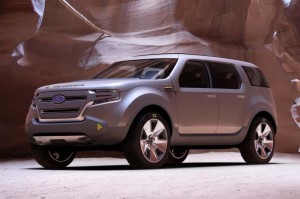
The production version of this Explorer concept vehicle will hit showrooms for 2011 -- and deliver a 30% bump in fuel economy, the maker says.
It’s been a decade since former Ford Motor Co. CEO Jacques Nasser pledged to increase the fuel economy of the maker’s trucks and sport-utility vehicles by “25-in-5.”
But while Ford will be a little late in that pledge to boost mileage 25% in 5 years, it will actually exceed the former chief executive’s goal, at least with the next-generation Ford Explorer, which the company has announced will get 30% better fuel economy than the old SUV.
A key reason behind that improvement is the complete shift in the design of what was once the most popular sport-ute in the U.S. Since its launch, Explorer relied on a truck-like, body-on-frame platform. The 2011 Ford Explorer will switch to a lighter, more car-like unibody platform.
Though specific details have yet to be released about the next Explorer – which will be formally unveiled by Ford CEO Alan Mulally, next Monday, at an event in New York’s Herald Square – the maker will replace the current ute’s 4.0-liter V6 with a version of the newer 3.5-liter six also going into the 2011 Ford Mustang. In the pony car, it will deliver 19 mpg in the city and 31 on the highway, but in the Explorer it would need to get 18/26 to deliver the promised 30% jump from the 4.0-liter engine’s 14/20 government rating.
A high-mileage version of the new 2.0-liter inline-four EcoBoost engine is reportedly also planned for Explorer, which could boost fuel economy even higher.
“The all-new Explorer will give a huge universe of existing and prospective customers the capability they expect and the luxury and convenience they want, all combined with the fuel economy they need,” said Mark Fields, Ford president of The Americas, in a statement.
The 2011 Ford Explorer will not only be lighter – as a result of the unibody platform – but make use of such fuel-saving technologies as electric power-assisted steering, a more efficient air conditioning system and deceleration fuel shut-off, which completes shuts down the flow of gasoline when the vehicle is coasting or decelerating.
The automaker has been pushing to gain a perceptive lead in green technology, something it seemed to be building under Nasser’s tenure. The executive promised a big increase in fuel economy, but eventually had to admit it couldn’t meet the 25-in-5 program’s goal.
Ford also has been struggling to rebuild demand for the Explorer, which began losing momentum after a safety crisis early in the decade, followed by the launch of the outgoing SUV model. The market became significantly more crowded with competing SUVs during that period, and Explorer also had to go up against a new generation of crossover-utility vehicles, including the Ford Edge, which has been the top-seller in its segment.
(Click Here for more on the 2011 Ford Explorer.)
Along with an emphasis on fuel economy, Ford will push safety in its innovative Explorer launch campaign. Among other features, the 2011 model will be the first to offer a novel rear seatbelt system with integrated airbags. And the new curve control technology is designed to make it easier to stay in control even if a motorist enters a corner faster than appropriate.

Will The Detroit Bureau be featuring any details about the more efficient air conditioning being used on the new Explorer? I’m sure many readers might be interested in how Ford accomplished this.
Hi, Steven,
Several of us will be at the Ford Explorer technical backgrounder, on Tuesday. Not sure if all will be on the record, embargoed or open for immediate publication, but yes, that’s one subject we will ask about.
Paul A. Eisenstein
Publisher, TheDetroitBureau.com